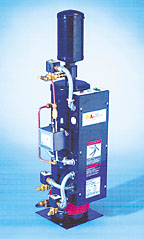A new product is said to address the problem of too much oil in the refrigerant, while keeping the oil at a level that actually helps system efficiency, according to Mark Key, vice president of component manufacturer Redi Controls.
The problem itself is pretty well known among engineers and manufacturers. Studies from the American Society of Heating, Refrigeration and Air Conditioning Engineers (ASHRAE) and the Air-Conditioning and Refrigeration Institute (ARI) have identified excess oil on the refrigerant side of the chiller as a leading contributor to oil inefficiency.
The problem also appears to be widespread.
EXCESS OIL
ASHRAE Research Project 601-TRP drew refrigerant samples from 10 operating chillers and analyzed them for oil content. While 10 chillers may not constitute a very broad study, all the units had excess oil, from 3% to as high as 23%. Even an amount as low as 3%, noted Key, is enough to “significantly degrade” oil performance.Key said that chiller OEMs have reported that most chillers in the field are running with an excess 12% of oil in the refrigerant. This amounts to roughly a 36% drop in efficiency — not taking into account other factors that may be affecting system efficiency.
Yikes.

PRODUCT CONTROLS OIL
Key said that his company’s OAM Purge unit can remove oil, acid, and moisture (that’s what “OAM” stands for), which can affect chiller efficiency and reliability. At the same time, it maintains an extremely low level of oil in the refrigerant that actually aids efficiency. The unit is designed to be used on low- and high-pressure screw and centrifugal chillers.“Standard chillers can have a percentage of oil contamination,” Key explained. “At 0.5% oil content, oil is a lubricant. Higher than that, it decreases system efficiency.” The OAM maintains oil content to 0.5%, Key said.
The product’s main purpose, however, is to remove oil and automatically return it to the chiller’s oil sump.
The company explains that the OAM purger “draws off a small quantity of refrigerant, typically 10 to 15 pounds at a time.” The refrigerant is distilled and returned to the chiller; the oil left behind returns to the oil sump. Acids and moisture, of course, are not returned once removed.
The unit operates 24 hours a day, the company says, “regardless of chiller operating status.” Nevertheless, the purger is a passive device, operating on gravity, heat, and pressure; it does not use an ejector pump, the company says.
RETROFITS
Key said the OAM can be retrofitted onto “any existing high- or low-pressure centrifugal or screw chiller.” Installation can be accomplished on existing chillers in about a half day, the company says; technicians need three 1/4-in.-OD copper line connections and a 120-V power supply.The unit costs about $6,000 to install, so it pays for itself in a little over half a year, Key said.
Chiller manufacturers have expressed interest in the product, he added; “It could be installed on chillers on the production line.”
Model OAM-PRG-LP100, for low-pressure centrifugal chiller applications, is available now; models for high-pressure centrifugal chillers and high-pressure screw chillers (OAM-PRG-HPCC100 and OAM-PRG-HPSC100) will be available in approximately six to eight weeks, Key said. The company also is gearing up for beta test sites.
For more information, contact Redi Controls, Greenwood, IN; 800-626-8640; 317-865-4130 (in Indiana); redi@redicontrols.com (e-mail).
Publication date: 07/08/2002

Report Abusive Comment